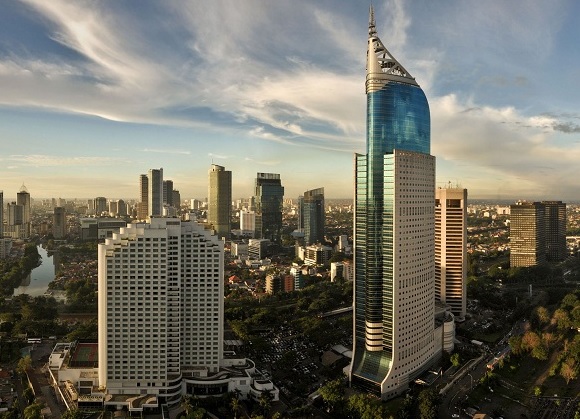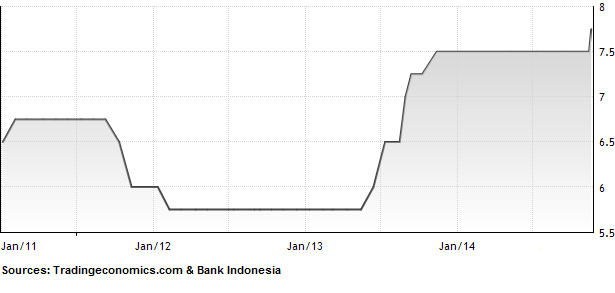Bank Indonesia’s BI Rate Unchanged after December Board Meeting
Indonesia’s central bank decided to keep its benchmark interest rate (BI rate) at 7.75 percent at Thursday’s Board of Governors’ Meeting (11/12). The Lending Facility and Deposit Facility were kept at 8.00 percent and 5.75 percent, respectively. The central bank is convinced that the current interest rate levels are effective to combat short-term inflationary pressures (triggered by the implementation of higher subsidized fuel prices in mid-November) pushing it back to the target corridor of between 3 and 4 percent (y/y) in 2015.

In November 2014, Indonesia’s inflation rose 1.50 percent month-to-month (m/m) or 6.23 percent on an annual basis. The impact of higher subsidized fuel prices on the pace of inflation is expected to continue into December and January 2015.
Inflation in Indonesia:
| Month | Monthly Growth 2013 |
Monthly Growth 2014 |
| January | 1.03% | 1.07% |
| February | 0.75% | 0.26% |
| March | 0.63% | 0.08% |
| April | -0.10% | -0.02% |
| May | -0.03% | 0.16% |
| June | 1.03% | 0.43% |
| July | 3.29% | 0.93% |
| August | 1.12% | 0.47% |
| September | -0.35% | 0.27% |
| October | 0.09% | 0.47% |
| November | 0.12% | 1.50% |
| December | 0.55% | |
| Total | 8.38% | 5.75% |
Source: Statistics Indonesia (BPS)
This (unchanged) interest rate environment (a relatively tight monetary policy) is also regarded as conducive in the context of curtailing Indonesia’s wide current account deficit. The central bank (Bank Indonesia) expects that this deficit will ease to about 3 percent of gross domestic product (GDP) by the year end (from 3.3 percent of GDP in 2013). Generally, a current account deficit below the 3 percent of GDP mark is regarded sustainable.
Between June 2013 and November 2013, Bank Indonesia gradually raised the BI rate from 5.75 percent to 7.50 percent in an effort to combat high inflation that was triggered by the subsidized fuel price hike in June 2013. For 12 months the central bank then left its interest rate regime unchanged. However, after the newly inaugurated government, headed by President Joko Widodo, decided to hike subsided fuel prices again Bank Indonesia immediately raised its key rate by 25 basis points to 7.75 percent. Although most analysts seem to agree with the central bank’s policy (as it safeguards macroeconomic and financial system stability), it does contribute to the country’s slowing economic growth. In Q3-2014, Indonesia’s economic growth slowed to a five-year low at 5.01 percent (y/y). Bank Indonesia expects that the slowdown continues in the last quarter of 2014 as consumption is expected to slow moderately, primarily due to weak government consumption in line with budget cuts as well as declining household consumption due to higher inflation. In the first quarter of 2015, however, enhanced government consumption (due to improved fiscal room) will result in investment activity (construction and non-construction) thus boosting economic growth. Therefore, Bank Indonesia projects GDP growth of about 5.2 percent (y/y) in 2014 and growing to 5.4-5.8 percent (y/y) in 2015.
Indonesia's Quarterly GDP Growth 2009–2014 (annual % change):
| Year | Quarter I |
Quarter II | Quarter III | Quarter IV |
| 2014 | 5.22 | 5.12 | 5.01 | |
| 2013 | 6.03 | 5.89 | 5.62 | 5.78 |
| 2012 | 6.29 | 6.36 | 6.16 | 6.11 |
| 2011 | 6.45 | 6.52 | 6.49 | 6.50 |
| 2010 | 5.99 | 6.29 | 5.81 | 6.81 |
| 2009 | 4.60 | 4.37 | 4.31 | 4.58 |
Source: Statistics Indonesia (BPS)
Gross Domestic Product of Indonesia 2006-2013:
| 2006 | 2007 | 2008 | 2009 | 2010 | 2011 | 2012 | 2013 | |
| GDP (in billion USD) |
285.9 | 364.6 | 432.1 | 510.2 | 539.4 | 706.6 | 846.8 | 878.0 |
| GDP (annual percent change) |
5.5 | 6.3 | 6.1 | 4.6 | 6.1 | 6.5 | 6.2 | 5.8 |
| GDP per Capita (in USD) |
1,643 | 1,923 | 2,244 | 2,345 | 2,984 | 3,467 | 3,546 | 3,468 |
Sources: World Bank, International Monetary Fund (IMF) and Statistics Indonesia (BPS)
In a statement the central bank said that the weakening of the Indonesian rupiah exchange rate against the US dollar will persist due to the economic recovery of the USA. Monetary tightening in the world’s largest economy (the Federal Funds Rate expected to be raised in the second quarter of 2015) leads to bullish momentum for the US dollar (nearly all global currencies are weakening against the US dollar). Looming higher interest rates in the USA implies that Indonesia may experience capital outflows in the months ahead.
Meanwhile, forecasts for Indonesia’s exports are still bleak as the economies of the Eurozone and Japan are sluggish (in need of stimulus) while China’s economic is experiencing a process of rebalancing (accompanied by economic slowdown). As such, international commodity prices are still under pressure.
Bank Indonesia also commented on the dramatically lower global oil price. As Indonesia is a net importer of oil, this constitutes a positive development for Indonesia’s balance of payments and the fiscal sector.
Bank Indonesia's BI Rate:


